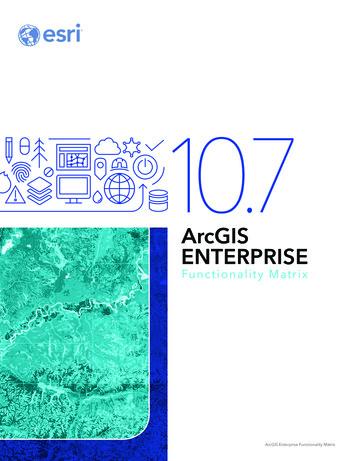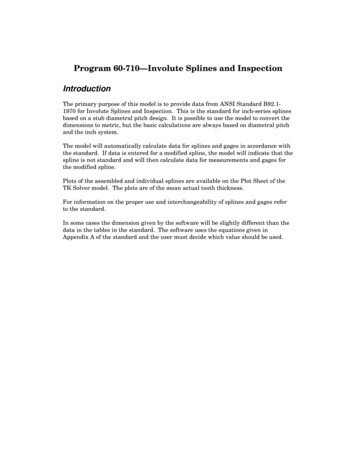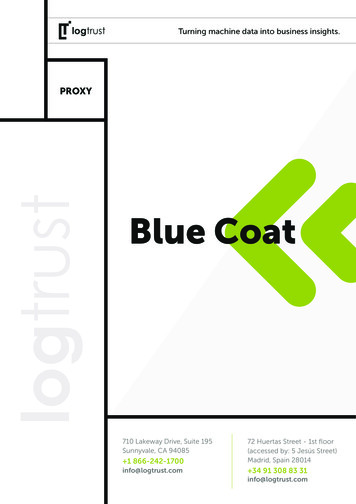
Transcription
10.710.5 &10.5.1ArcGISENTERPRISEFu n c t i o n a l i t y M at r i xArcGIS Enterprise Functionality Matrix
ArcGIS Enterprise is flexible server software for mappingand analytics that allows you to easily manage your locationenabled data and brings a Web GIS into your infrastructure.ArcGIS Enterprise provides your organization with the power toanalyze, create, and share content to any device, anywhere, atany time—helping you to discover and do more with your data.Designed for flexibility, ArcGIS Enterprise gives you completecontrol over the infrastructure the software will use andsupports deployments using physical or virtualized machinesand cloud infrastructure alike. ArcGIS Enterprise also comes withtools to make getting started easier, including wizard-basedbuilder for all-in-one deployments, Chef and PowerShell DSCscripts to automate custom deployments, and machine imagesto jump-start cloud deployments on Amazon Web Services andMicrosoft Azure.The ArcGIS Enterprise portal enables Web GIS and allowsmembers of your organization to search, organize, analyze,store, and share location-enabled content; with it, you cantransform raw data into a fully functional mobile app withoutwriting a single line of code.At the heart of ArcGIS Enterprise is powerful server softwarewith capabilities that allow you to serve, map, and analyzegeographic information. The vast and diverse capabilities ofArcGIS Enterprise are organized into different servers, eachone unlocking a distinct array of functionality. This functionalitymatrix is organized so that you can identify which servers bestfit your needs.Powerful, collaborative, and secure—ArcGIS Enterpriseepitomizes modern GIS in your rix11
ISGISSERVER eoEventSGeoerveAnralyticNsSoteberooverkServerFun ct ionality MatrixRun on WindowsRun on LinuxDeploy in the cloudDeploy on-premisesOnly applicable if you havethe correspondingArcGIS Desktop extensionDeploy disconnected from the open InternetScript and automate workflowsCreate analytical models and model chainsEdit data on the webCreate OGC-compliant web servicesConvert location information to x,y (geocode)Visualize data as a schematic diagramSupport disconnected/field editingCreate geoprocessing services fromArcGIS Desktop analysis toolsCreate geoprocessing services as web toolsServe ArcGIS 3D Analyst tools 1Serve Business Analyst tools and apps02Serve ArcGIS Geostatistical Analyst tools 103Serve ArcGIS Spatial Analyst tools 104Create image and raster mosaics dynamically05Display imagery and raster data on the fly06Process and analyze big dataAnalyze streaming data in real time07Generate geoenabled alerts08Create geofences09Utilize data science libraries10Enrich dataArcGIS Enterprise Functionality Matrix11
IncludedAdditionalPurchase23The only geoprocessingservices that can be servedare those that arepreconfigured within theserver; you cannot add ormodify geoprocessingservices.ArcGIS Network Analyst forServer extension is SERVICE TYPESCached service—Map, imageDynamic map serviceFeature serviceFeature service (read-only)Geocoding serviceGeodata serviceGeometry service²Geoprocessing serviceImage service—From mosaic datasetImage service—From single rasterNetwork service³Print serviceReady-to-use Python NotebooksSchematic serviceStream serviceHOSTED LAYER TYPESFeature layerImagery layerScene layer02Raster tile layer03Vector tile layer04CONTENT05ArcGIS Living Atlas of the World06StreetMap Premium for ArcGIS(Display, Routing, Geocoding)07080910ArcGIS Enterprise Functionality Matrix11
IncludedAdditionalPurchase4Windows Only5GeoEvent Server can ingestdata from system files, whichmay be in a table format.GeoEvent Server can alsopoll a feature service forfeature records, which aremaintained in a feature classor table. But direct databasetable support is not included;queries need to be madethrough a feature service.6ArcGIS Utility NetworkManagement extension ISEXTENSIONSArcGIS Network Analyst for ServerArcGIS for INSPIREArcGIS Data Interoperability for Server 4ArcGIS Data Reviewer for Server 4ArcGIS Utility Network ManagementArcGIS Workflow Manager for Server 4ArcGIS for Maritime: Server 4Esri Defense Mapping for Server 4Esri Production Mapping for Server 4Esri Roads and Highways for Server 4INPUT DATA TYPES3D feature (point, object, extrusions)3D scenesAddress locatorsBig data—FeatureBig data—Imagery/RasterFeature data (points, lines, polygons)Imagery/Raster data—Mosaic datasetImagery/Raster data—Single raster02Integrated mesh03Lidar/Terrain data—Mosaic dataset04Lidar/Terrain data—Single raster05Multipatch data06Point clouds07Raster elevation surfaces08Real-time data streamsUtility networks095Tabular data666ArcGIS Enterprise Functionality Matrix1011
Portal capabilities areunlocked by the role youassign the user type. Anyof the default roles canbe modified to create acustom role.rwerEditoVieataDCOMPATIBLE USER TYPESAdminiPu stratoblrisherUserUser RolesGIS ProfessionalCreatorField WorkerEditorViewerPORTAL CAPABILITIESBrowse and view data, map layers, web maps, and appsVisualize data on a mapVisualize data in 3DQuery and filter data dynamicallySearch for a location (geosearch)Generate turn-by-turn directionsChange the way the data is styled (symbolize)Measure distancesAdd itemsPublish layers from existing itemsConvert location information to x,y (geocode)Save data as map layers and web mapsShare data, map layers, and web maps with othersCreate web mapping applications from web mapsEdit data02Save modified data as a new item03Analyze data04Organize content into groupsApply security to data, map layers, web maps, and apps05Create dynamic data views as layers06Use the built-in site builder to create custom landing pagesEstablish trusted sharing to another GIS07Manage app licensing08Add and manage user membership of the GIS09Disable member accountsDelete members10ArcGIS Enterprise Functionality Matrix11
SupportedDatabasesand DataConnections7To use cloud-hosteddatabases, your ArcGISEnterprise deploymentmust be colocated with thedatabase in the same cloudenvironment.8Compatible with publishingworkflows between ArcGISEnterprise 10.6 and ArcGISPro 2.1. SAP HANA enterprisegeodatabases cannot beused with older versions ofArcGIS Enterprise or ArcGISDesktop (ArcMap or ArcGISPro). Not compatible withArcMap.9GeoAnalytics also supportswriting your analysis resultsback to these sources.10Shapefiles, Parquet, ORC,and delimited files arecompatible.11GeoEvent Server inputconnectors included inthis section are only thoseconnectors that ship with thesoftware. AdditionalGeoEvent Server inputconnectors can be added tothe software from the ArcGISGeoEvent Gallery and ArcGISGeoEvent Partner Gallery.Supported database types forenterprise geodatabases query layersSupported database typesfor query layersAmazon Aurora PostgreSQLAmazon RDS for Microsoft SQL Server 7Amazon RDS for PostgreSQL 7IBM DB2IBM InformixMicrosoft SQL ServerMicrosoft Azure SQL Database 7Microsoft Azure Database for PostgreSQLOraclePostgreSQLSAP HANA 8AltibaseDamengIBM NetezzaSQLiteTeradataInput data supported byGeoAnalytics ServerRaster stores supported by ImageServer when running Raster AnalyticsHosted feature layersFeature servicesStream servicesBig Data File Shares- Apache Hadoop HDFS 9- Apache Hive- AWS S3 9, 10- Azure Data Lake Store 9, 10- Local and Network File Shares 9, 10- Microsoft Azure Storage 9Alibaba Cloud OSSAWS S3Huawei Cloud OBSLocal File SharesMicrosoft Azure StorageInput connectors supported byGeoEvent Server 11ArcGIS ServerFile (CSV, JSON)RSSSocket (TCP, UDP)Web (REST, JSON, GeoJSON, XML)WebSocket (JSON, GeoJSON)020304050607080910ArcGIS Enterprise Functionality Matrix11
Supported CloudEnvironmentsSupported OGC andOpen Web ServicesSecurity,Authentication, andAuthorizationArcGIS Enterprise can be deployedon any cloud platform usinginfrastructure that meets the systemrequirements. For Amazon WebServices (AWS) and Microsoft Azure,ArcGIS Enterprise comes withprebuilt images and deploymenttooling that makes it even easierto install and configure yourdeployment.As part of Esri’s Open Vision, ArcGISGIS Server (Advanced and Standard)in ArcGIS Enterprise can serve outthe following Open GeospatialConsortium (OGC) and open webservices:ArcGIS Enterprise comes witha robust and effective securityframework that includes optionsfor managing access and enforcingpermissions for secured resources.Supported configurable securitysettings include the following:In addition to deploying in variouscloud platforms, ArcGIS Enterprisehas support for cloud native featuresin several clouds. This includessupport for cloud native storageand support for cloud manageddatabases. See this functionalitymatrix for an overview and thedocumentation for specific detailson what features are supported withthe different cloud stores.Cloud native storage AWS S3 Microsoft Azure Storage Alibaba Cloud OSS Huawei Cloud OBS WMS—Web Map Service(versions 1.0, 1.1, 1.1.1, and 1.3) WFS—Web Feature Service(versions 1.0, 1.1, and 2.0) WCS—Web Coverage Service(versions 1.0.0, 1.1.0, 1.1.1, 1.1.2,and 2.0.1) WMTS—Web Map Tile Service(version 1.0) WPS—Web Processing Service(version 1.0) Web-tier authentication (IWA, PKI) GIS-tier authentication(built-in identity) Enterprise logins (SAML 2.0) Enterprise Groups (ActiveDirectory, LDAP, and SAML 2.0) TLS 1.2 and optional supportfor TLS 1.0 and TLS 1.1 forbackwards compatibility KML—Keyhole Markup Language(version 2.2)02 GeoJSON03ArcGIS Server licensed as ImageServer will be able to serve outWeb Coverage Services at the sameversion levels as listed for ArcGISGIS Server.04050607080910ArcGIS Enterprise Functionality Matrix11
DeployingArcGISEnterprisein sequence, or you can automate the deployment process by using one of the ArcGISEnterprise deployment automation tools. Before deciding on a deployment automationtool, you should have planned the type of deployment that you will need (for example,single-machine, highly available) and be aware of any other system or architecturalWindows, Linux, in a cloud environment).The following matrix compares common deployment characteristics with the ArcGISEnterprise deployment automation tools and can be a useful guide in choosing theappropriate deployment automation tool.ABu rcGild ISer EnterpriseureAzSAWerPowDEPLOYMENT CHARACTERISTICSfShellDSCAutomation toolheOnly a deployment that wasset up using the tool can beupgraded.C12Cloud deploymentsOn-premises deploymentsWindows OSLinux OSSingle-machine deploymentsMulti-machine deploymentsHigh availability deploymentsSet up base ArcGIS Enterprise deploymentSet up GIS ServerSet up Image ServerSet up GeoEvent ServerSet up GeoAnalytics Server02Set up Notebook Server03Can be used to upgrade the deployment 12040506Provides command line interface07Provides wizard-style interface080910ArcGIS Enterprise Functionality Matrix11
User TypeLicensing13The Workgroup level ofArcGIS Enterprise supportsa maximum of 10 users perdeployment regardless ofedition. ArcGIS EnterpriseWorkgroup Standardincludes five Creator UserTypes. You can add upto five additional NamedUsers (Viewer, Creator, ora combination thereof), solong as the total number ofusers for your organizationdoes not exceed 10. AsArcGIS Enterprise WorkgroupAdvanced already includes10 Creator User Types,additional Named Users (ofany level) cannot be added.NAMED USER LICENSESArcGIS Enterprise uses an identity-based security model. To access content securedwithin ArcGIS Enterprise, individuals must be a member of the ArcGIS Enterprisedeployment and have an identity within the system. Throughout ArcGIS, identities areprovisioned and allocated through User Type licensing.There are five general-purpose User Types: Viewer, Editor, Field Worker, Creator, andGIS Professional. Viewers can access, view, and interact with any of the items in yourportal but cannot edit, share, or create any new content. ArcGIS Enterprise Standardand Advanced include unlimited Viewers at no additional cost. Creators can beassigned a broad range of privileges. Users with the Creator User Type can create, own,analyze, share, and store data and content within the ArcGIS Enterprise portal.The Editor, Field Worker, and GIS Professional user types include a mix of capabilitiesand included applications. For example, the Field Worker can edit existing datasetsthrough field apps like Survey123, Workforce, and Collector. The Editor can editexisting data and add new data. The GIS Professional can do everything a Creator usertype can do, and includes access to ArcGIS Pro.USER TYPES INCLUDED WITH INITIAL PURCHASEArcGIS ENTERPRISEEDITION/LEVELCREATORUSER TYPEVIEWERUSER TYPEArcGISEnterprise Standard5Unlimited50ArcGISEnterprise AdvancedArcGIS EnterpriseWorkgroup Standard 13ArcGIS EnterpriseWorkgroup Advanced 135010Unlimited002Note: The information listed here may not be applicable if you licensed ArcGISEnterprise as part of a special program, such as an enterprise agreement (EA) oran Education Site License. Contact your Esri representative for more details on howUser Types apply to your organization.Historical: A Viewer is functionally equivalent to a Level 1 Named User found inprevious releases and a Creator is equivalent to a Level 2 Named User.0304050607080910ArcGIS Enterprise Functionality Matrix11
LicensingArcGIS ENTERPRISE STANDARD AND ADVANCEDYou can license ArcGIS Enterprise in two editions, offered at two different capacitylevels. The editions are Standard and Advanced, and the levels are ArcGIS Enterpriseand ArcGIS Enterprise Workgroup. Collectively, we refer to ArcGIS Enterprise to meanany edition or level when there isn’t a need to distinguish.ArcGIS ENTERPRISE WORKGROUP LEVELArcGIS Enterprise Workgroup is a lower capacity level of ArcGIS Enterprise. It offersall the same functionality as ArcGIS Enterprise but is designed for use in smaller teamsand organizations. The Workgroup level has the following differences: There is a limit of 10 simultaneous desktop connections to workgroupgeodatabases. Workgroup geodatabases are only supported on Microsoft SQLServer Express and have a maximum size of 10 GB. The Workgroup level is only licensed for use with file-based data sources (e.g., filegeodatabases) and workgroup geodatabases. It is not licensed for use withenterprise geodatabases. The base ArcGIS Enterprise deployment must be deployed all-in-one on a singlemachine with up to four cores. Each server role has a four-core maximum. The additional roles can be deployed onmachines that are separate from the base deployment. The spatiotemporal big data storefrom ArcGIS Data Store may be configured on a single, separate four-core machine.For more information and to determine if ArcGIS Enterprise Workgroup is a good fit foryour organization, contact your local Esri representative.OTHER SERVER LICENSINGArcGIS GIS Server Basic is a limited-functionality GIS server that primarily providesenterprise geodatabase functionality. ArcGIS GIS Server Basic cannot be federatedas part of an ArcGIS Enterprise deployment and does not enable any Web GISaccess for functionality.020304050607080910G366094ArcGIS Enterprise Functionality Matrix11
and cloud infrastructure alike. ArcGIS Enterprise also comes with tools to make getting started easier, including wizard-based builder for all-in-one deployments, Chef and PowerShell DSC scripts to automate custom deployments, and machine images to jump-start cloud











